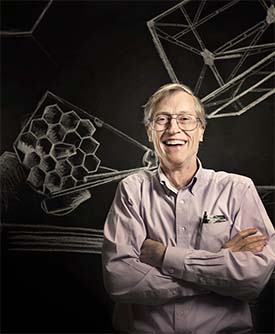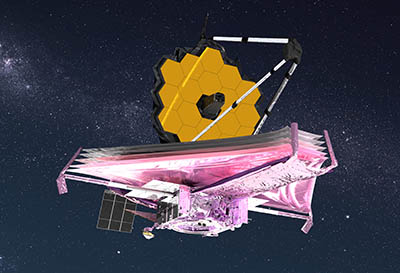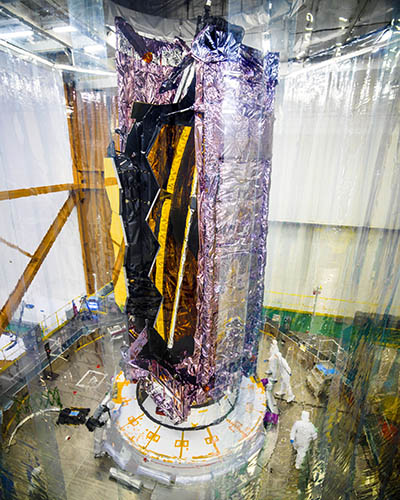Searching for Signs of Life Beyond Our Solar System
Nobel Laureate John Mather Speaks about NASA’s James Webb Space Telescope
What if life does indeed exist on distant planets? And what if biogenesis–the development of life–is actually quite common, or could be found in abundance throughout the universe? Perhaps there are yet-undiscovered laws of nature that could help answer these questions. In order to find out, “We have to go measure!” said John Mather, who is a senior astrophysicist at NASA’s Goddard Space Flight Center (Greenbelt, Maryland). No stranger to investigating perplexing cosmic questions, Mather shared the 2006 Nobel Prize in physics with George Smoot for measuring the electromagnetic radiation produced by the Big Bang.

CREDIT: CHRIS GUNN, NASA
NASA astrophysicist John Mather wowed an NIH Zoom audience with his stories on how the Webb telescope will journey into outer space to find signs of life outside our solar system.
Mather is also the senior project scientist for the James Webb Space Telescope, an infrared telescope 100 times as powerful as its precursor, the Hubble Space Telescope. Launched into space by ArianeSpace from Kourou, French Guiana, in December 2021, the Webb will send back its first images this summer. In a recent Demystifying Medicine lecture at NIH, Mather spoke about how the Webb telescope will search for signs of life beyond our solar system and provide clues on how the early universe evolved and gave rise to the first stars, galaxies, planets, and ultimately, life.
At a low-Earth orbit 340 miles above Earth, the Hubble telescope has been sending back spectacular images of the solar system and deep space since 1990. It has discovered thousands of exoplanets, planets outside of our solar system. But according to Mather, the Hubble is not able to pick up the oldest infrared light coming from the most ancient parts of the universe—it doesn’t look far enough back in time. When space expands, light stretches, and the universe has been expanding since the Big Bang 13.8 billion years ago.
Light energy from early cosmic events that is just reaching us now has been stretched out to the infrared part of the electromagnetic spectrum in a phenomenon known as cosmological redshift. The longer the wavelength the older the light, and unlike visible starlight, infrared radiation can permeate clouds of dust and gas. Studying this redshifted energy allows astronomers to peer though curtains of cosmic debris to see the light emitted from primordial stars that formed just 100 to 250 million years after the Big Bang, a time known as the cosmic dawn. Those early stars are thought to have been hundreds of times as massive as our sun, eventually exploding into supernovae and seeding the universe with the raw elements that led to the formation of galaxies such as the Milky Way. Much is unknown about this early epoch. So, in 1996, NASA began a decades-long collaboration with the European and Canadian space agencies to develop the Webb telescope, the world’s most advanced space observatory with acute infrared-sensing capabilities.

CREDIT: CHRIS GUNN, NASA
This artist’s concept shows NASA’s James Webb Space Telescope fully unfolded in space.

CREDIT: DESIREE STOVER, NASA
NASA technicians used a crane to lift the Webb telescope and moved it inside a clean room at NASA’s Goddard Space Flight Center (Greenbelt, Maryland). Once in space, the Webb telescope’s 18-segmented gold mirror will unfold to capture infrared light from the first galaxies that formed in the early universe and will help the telescope peer inside dust clouds where stars and planetary systems are forming today.
Like a giant honeycomb, 18 gold-plated hexagons make up the telescope’s primary mirror. Measuring more than 21 feet across, it’s part of an impressive optics system that could detect a bumblebee 240,000 miles away. The Webb is perched at a vantage point nearly 1 million miles beyond Earth around the second Lagrange point (L2), a special position in space where a balance of gravitational force keeps the telescope moving along with Earth as it orbits the Sun.
A five-layer sunshield the size of a tennis court protects the telescope’s optical mirrors and four infrared-detecting instruments from our sun’s intense radiation. According to NASA, the hot side of the sunshield will reach 185 degrees Fahrenheit, while the space-facing side will cool to minus 388 degrees Fahrenheit, frigid enough to freeze nitrogen. The detecting hardware needs to be kept cold to reduce the infrared energy, which could be picked up as false signals, emitted by the telescope’s own optics.
When Webb reached L2 in January 2022, engineers began a delicate five-month process of remote calibration and testing from the Space Telescope Science Institute in Baltimore, which serves as the science operations center for the mission. The Webb telescope is beyond the range of astronaut repair crews, and thus far, the commissioning process has gone according to plan.
What could future discoveries made by the Webb telescope teach us about our own beginnings? In his talk, Mather painted a picture of a tumultuous expanding universe ruled by ever-increasing entropy. Matter is pulled back together by gravity, and nature is perpetually trying to stabilize itself by reorganizing into complex systems in a dance of energy redistribution. We see this in the birth of stars igniting from collapsing clouds of interstellar gas and dust. Here on Earth, algae, cyanobacteria, and plants evolved to convert that starlight into simple sugars, pumping out the oxygen so essential to human life. Or consider DNA, essentially a digital code of base pairs that allows for unlimited genetic complexity in carbon-based lifeforms.

CREDIT: CHRIS GUNN, NASA
This image shows the James Webb Space Telescope atop its launch vehicle, but before it was encapsulated in the rocket fairing. The telescope is encased in protective clean tent.
“Maybe life is a thermodynamic imperative,” said Mather, alluding to the possibility that metabolism and life could be common responses to energy flowing in the right places, such as in the presence of liquid water and carbon. Here on Earth, scientists have found evidence of basic cell structures and organic chemical processes living on nonorganic compounds surrounding deep-sea hydrothermal vents. Perhaps similar things are happening on rocky wet planets elsewhere—or even everywhere.
Scientists will use the Webb to analyze light passing through the atmospheres of exoplanets dozens to hundreds of light-years away. Measuring how light is absorbed and reflected can indicate the presence of water, oxygen, and other biosignatures that could indicate life. Astronomers will also be looking closer at intriguing targets in our solar system such as Saturn’s moon Titan, which has an atmosphere, water, and hydrocarbons.
Webb could make discoveries that redefine our current understanding of physics. “Where I think we could get a big surprise is about dark energy and dark matter and what they did to the early universe,” said Mather in an interview with this reporter. Dark matter and dark energy cannot be seen directly, but their gravitational influence can. The existence of these mysterious entities helps explain why cosmic expansion is accelerating and why some stars and galaxies are zipping around more quickly than could be explained by their self-generated gravity alone.
Over 80% of the observatory’s prime viewing time will be individually allocated to scientists from around the world. A selection committee at the Space Telescope Science Institute evaluates anonymously submitted research proposals that are judged solely on scientific merit. All data generated by scientists using the telescope will eventually be made public and available to other researchers.
Webb’s mission is expected to last approximately 10 years with prospects for 20. So, what’s next? Every decade, a committee assembled by the National Academy of Sciences prioritizes scientific goals and proposes new missions to NASA. They recommended a new generation of space telescope that will be an even more accurate exoplanet hunter. It could have the technology to detect oxygen on alien worlds from an immense distance, or find surface features such as an ocean by measuring subtle variations in light reflecting off the surface of a planet.
Astrophysicists and astronomers are driven by an innate curiosity to imagine, observe, and measure. Their discoveries get us closer to answering our most basic questions: Are we alone, and where did we come from? “We have a lot of imagination even if we don’t have a lot of knowledge yet,” said Mather. “And that’s important because imagination tells you where to look.”
To watch a videocast of this seminar, presented on April 12, 2022, go to https://videocast.nih.gov/watch=44332. For more about the Demystifying Medicinecourse, go to https://demystifyingmedicine.od.nih.gov. The Demystifying Medicine course, established and run by Irwin Arias, is in its 21st year and aims to bridge exciting developments in medicine with advances in the basic biological and engineering sciences. You can view past videocasts (dating back to 2003) at https://videocast.nih.gov/PastEvents.asp?c=45.
This page was last updated on Thursday, June 30, 2022
